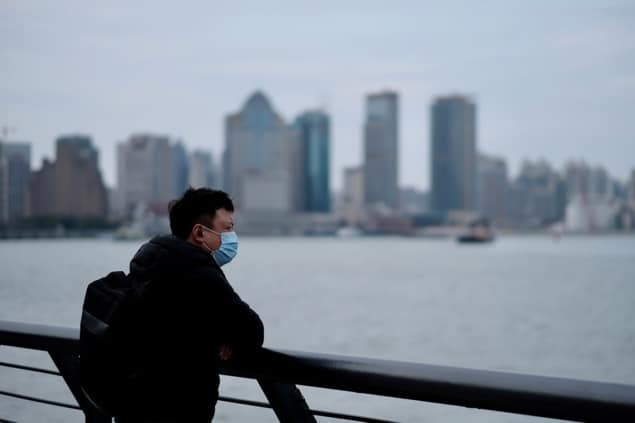
Research on the fluid dynamics of respiratory emissions indicates that individuals infected with COVID-19 could spread viral particles up to 8 metres away when they cough or sneeze – a finding that appears to undermine statements by the World Health Organization (WHO) that “airborne transmission” of the novel coronavirus is not possible.
Current WHO guidelines for respiratory disease containment are based on a model of droplet spray transmission that dates from the 1930s. In this model, air resistance prevents single droplets released in respiratory emissions from travelling more than 2 metres from their source – a distance that has appeared prominently in public-health messages during the current pandemic. However, modern techniques have shown that clouds of turbulent gas in exhalations – that is, coughs and sneezes – can convey droplets much further than is possible for lone droplets in ballistic flight.
In a paper published in JAMA Insights on 26 March, Lydia Bourouiba, an applied mathematician and head of the Fluid Dynamics of Disease Transmission Laboratory at the Massachusetts Institute of Technology, US, outlines the implications of these newer techniques and her ongoing work on the fluid dynamics of respiratory emissions. “A turbulent gas cloud is critical to include in the picture,” she says. “Droplets trapped in the cloud can go further than isolated droplets, about 5 metres for coughs and 7-8 metres for sneezes.”
Based on her results, Bourouiba argues that in the current pandemic, “it is not possible to support that there is a safe distance of 1-2 metres in a healthcare setting full of symptomatic patients who emit such violent exhalations.” For this reason, she says, “protection of healthcare workers at the frontline has to be of higher respiratory grade.”
Enough evidence?
Bourouiba and her colleagues have been quantifying influenza respiratory emissions since 2016 using an imaging technique known as high-frequency frame capture illumination. These studies have shown that, because the swiftly-moving exhalation cloud tends to keep droplets together and trap them within a humid environment, evaporation can take minutes, rather than seconds.
The JAMA Insights paper includes several visualizations of the exhalation cloud’s spread, and Julian Tang, a virologist at the University of Leicester, UK, who has expertise in respiratory viruses and their transmission, says he finds them convincing. “You can see from the image and video that it [the exhalation cloud] does spread, which could be enough to convey and transport the infectious virus all the way along that pathway,” says Tang, who was not involved in Bourouiba’s study.
As for why the WHO guidelines do not take such possibilities into account, Tang offers two potential explanations. One is that there is no direct proof that coronavirus particles inhaled from such a gas cloud will cause infection. However, he notes that the huge number of variables and confounders at play – not to mention practical and ethical issues of doing experiments on such a new and deadly disease – make it nearly impossible to conduct a conclusive study quickly enough to affect the evolving pandemic situation.
“That level of proof [required by the WHO] is so ridiculously difficult that it precludes you doing any airborne precaution and infection control now,” he says. Even without such proof, he thinks the WHO should at least acknowledge the possibility of airborne transmission. “It’s the precautionary principle,” he says. “You try and prevent transmission if it’s potentially possible.”
The other possible explanation, Tang adds, has more to do with economics. “The WHO can’t endorse a mode of transmission which low- and middle-income countries can’t do anything about,” he says. While washing hands and cleaning surfaces to prevent droplet transmission is relatively cheap and easy, Tang explains that the possibility of airborne transmission means that healthcare workers on clinical wards might need expensive, full personal protective equipment (PPE) to prevent them from becoming infected.

Bacteria manipulate bubbles to maximize airborne dispersal
As it stands, even well-off countries like the UK are struggling to provide adequate PPE for frontline healthcare workers. But that, he argues, is no excuse to ignore these results. “When you see all these studies showing the dissemination of airborne particles, it’s very hard to deny they could be a risk,” he says. “’Can’t afford it’ is one thing, but they shouldn’t say it just doesn’t happen.”
Policy shift
On 2nd April, BBC News reported some movement in the WHO’s position, with the chair of its advisory panel, David Heymann, announcing that the organization is “opening up its discussion again, looking at the new evidence to see whether or not there should be a change in the way it’s recommending masks should be used.”
For Bourouiba, whose research has also appeared in a TEDMED Talk, and who established a new conference to bring together policy makers and scientists, such movement is welcome. “I’m glad that the science has gotten to the committee, but we need, as a system and community, to find ways to improve translation time from the frontline of research to guidelines and policies sooner,” she says, adding that she has contacted the US Center for Disease Control and Prevention with her findings.
- This article was amended on 7 April 2020 to clarify how Bourouiba has worked to communicate her research findings outside the academic community.



